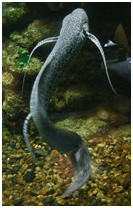1.6: The Nuclear Genome
- Page ID
- 3973
The C-value of the nuclear genome
The complete set of DNA within the nucleus of any organism is called its nuclear genome and is measured as the C-value in units of either the number of base pairs or picograms of DNA. There is a general correlation between the nuclear DNA content of a genome (i.e. the C-value) and the physical size or complexity of an organism. Compare the size of E. coli and humans for example in Table \(\PageIndex{2}\).
|
DNA content (Mb, 1C) |
Estimated gene number |
Average gene density |
Chromosome number (1N) |
|
|---|---|---|---|---|
|
Homo sapiens |
3,200 |
25,000 |
100,000 |
23 |
|
Mus musculus |
2,600 |
25,000 |
100,000 |
20 |
|
Drosophila melanogaster |
140 |
13,000 |
9,000 |
4 |
|
Arabidopsis thaliana |
130 |
25,000 |
4,000 |
5 |
|
Caenorhabditis elegans |
100 |
19,000 |
5,000 |
6 |
|
Saccharomyces cerevisiae |
12 |
6,000 |
2,000 |
16 |
|
Escherichia coli |
5 |
3,200 |
1,400 |
1 |
There are, however, many exceptions to this generalization, such as the human genome contains only 3.2 x 109 DNA bases, while the wheat genome contains 17 x 109 DNA bases, almost 6 times as much. The Marbled Lungfish (Protopterus aethiopicus – Figure \(\PageIndex{16}\)) contains ~133 x 109 DNA bases, (~45 times as much as a human) and a fresh water amoeboid, Polychaos dubium, which has as much as 670 x 109 bases (200x a human).

Fig 1.16: Marbled Lungfish. (Wikipedia-OpenCage-CC:AS)
The C-value paradox
This apparent paradox (called the C-value paradox) can be explained by the fact that not all nuclear DNA encodes genes – much of the DNA in larger genomes is non-gene coding. In fact, in many organisms, genes are separated from each other by long stretches of DNA that do not code for genes or any other genetic information. Much of this “non-gene” DNA consists of transposable elements of various types, which are an interesting class of self-replicating DNA elements discussed in more detail in a subsequent chapter. Other non-gene DNA includes short, highly repetitive sequences of various types.
Other genomes
Organelles such as mitochondria and chloroplasts also have their own genomes. These are, compared to the nuclear genome, relatively small and are also circular, like the prokaryotes from which they originated (Endosymbiont hypothesis).


